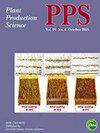Genetic analysis of biochemical, fiber yield and quality traits of upland cotton under high-temperature
IF 1.3
3区 农林科学
Q2 AGRONOMY
引用次数: 17
Abstract
ABSTRACT To understand the effect of heat stress on morphology and physiology of the cotton, eight cotton genotypes with their 15F1 hybrids (five lines, three testers) were grown in the field conditions under randomized complete block design (RCBD) with two treatments i.e. normal and high-temperature stresses with two replications followed by split-plot arrangement. Data were collected for biochemical and yield-related parameters. Mean values of all studied traits were reduced significantly under high-temperature stress whilst the mean value of lint%, catalase activity, total soluble proteins, peroxidase, and carotenoids were increased under high-temperature. Under both conditions, the number of bolls, boll weight, seed cotton yield, lint index, seed mass per boll, hydrogen peroxide content, catalase activity, total soluble proteins, carotenoids, and chlorophyll contents had high heritability values along with high genetic advance percent mean which revealed, these traits were controlled by additive gene action. The lint%, seed index, short fiber index, fiber strength, fiber fineness, upper half mean length and peroxidase activity had high heritability with moderate genetic advance under heat stress conditions which showed, these traits were controlled by non-additive gene action. Under both temperature conditions, FH-458, IUB-65, CRS-2, and FH-313 were good general combiners for physicochemical and yield-related traits. The cross combination of IUB-013× CRS-2 and FH-458× FH-313 were good specific combiner for plant height and seed cotton yield whilst for fiber quality and biochemical traits, the best specific combiners were VH-329× FH-313 and IUB-013× CRS-2. These identified parents and cross combinations might be used for improving already present commercial varieties under high-temperature stress.高温条件下陆地棉生化、纤维产量和品质性状的遗传分析
摘要为了解热胁迫对棉花形态和生理的影响,采用随机完全区组设计(RCBD),在大田条件下进行8个棉花基因型及其15F1杂交种(5个品系,3个试验品系)的正常和高温胁迫2个处理,2个重复,然后进行裂地安排。收集了生化和产量相关参数的数据。高温胁迫显著降低了各性状的平均值,提高了棉%、过氧化氢酶活性、总可溶性蛋白、过氧化物酶和类胡萝卜素的平均值。在两个条件下,铃数、铃重、籽棉产量、皮棉指数、单铃粒质量、过氧化氢含量、过氧化氢酶活性、总可溶性蛋白、类胡萝卜素和叶绿素含量均具有较高的遗传率和遗传超前率平均值,说明这些性状受加性基因作用控制。衣分、种子指数、短纤维指数、纤维强度、纤维细度、上半平均长度和过氧化物酶活性在热胁迫条件下具有较高的遗传力和适度的遗传推进,说明这些性状受非加性基因作用控制。在两个温度条件下,FH-458、IUB-65、CRS-2和FH-313是物化性状和产量相关性状较好的综合组合。IUB-013× CRS-2与FH-458× FH-313杂交组合在株高和种棉产量方面具有较好的特异组合,而在纤维品质和生化性状方面,最佳特异组合为VH-329× FH-313和IUB-013× CRS-2。这些鉴定的亲本和杂交组合可用于高温胁迫下改良现有的商品品种。
本文章由计算机程序翻译,如有差异,请以英文原文为准。
求助全文
约1分钟内获得全文
求助全文
来源期刊

Plant Production Science
农林科学-农艺学
CiteScore
5.10
自引率
4.00%
发文量
27
审稿时长
>36 weeks
期刊介绍:
Plant Production Science publishes original research reports on field crops and resource plants, their production and related subjects, covering a wide range of sciences; physiology, biotechnology, morphology, ecology, cropping system, production technology and post harvest management. Studies on plant production with special attention to resource management and the environment are also welcome. Field surveys on cropping or farming system are also accepted. Articles with a background in other research areas such as soil science, meteorology, biometry, product process and plant protection will be accepted as long as they are significantly related to plant production.
 求助内容:
求助内容: 应助结果提醒方式:
应助结果提醒方式:


